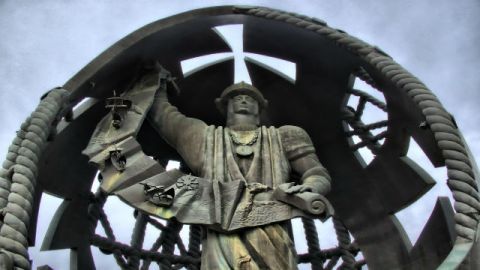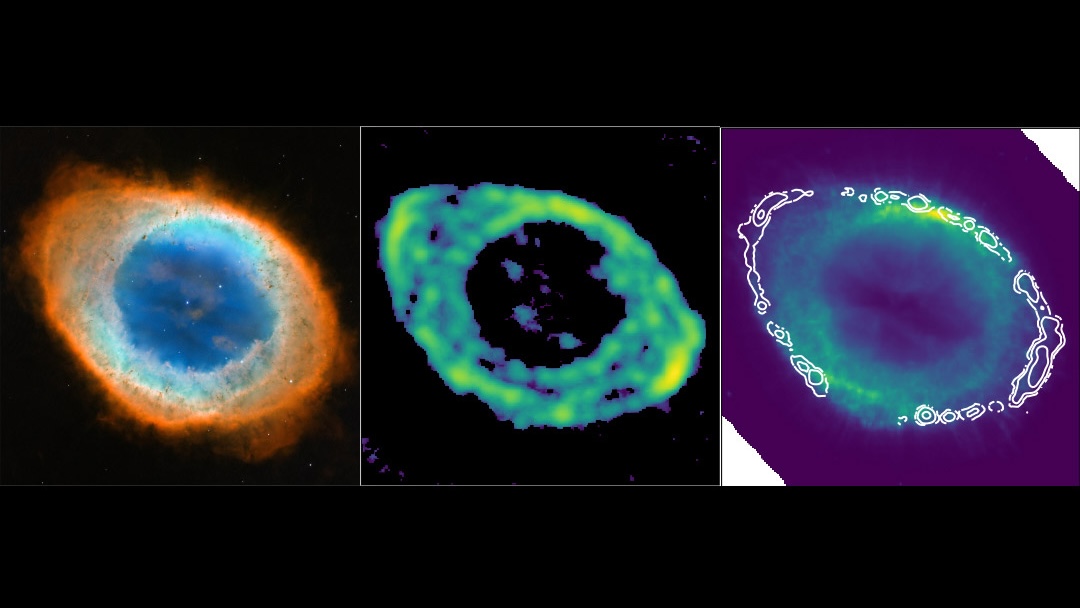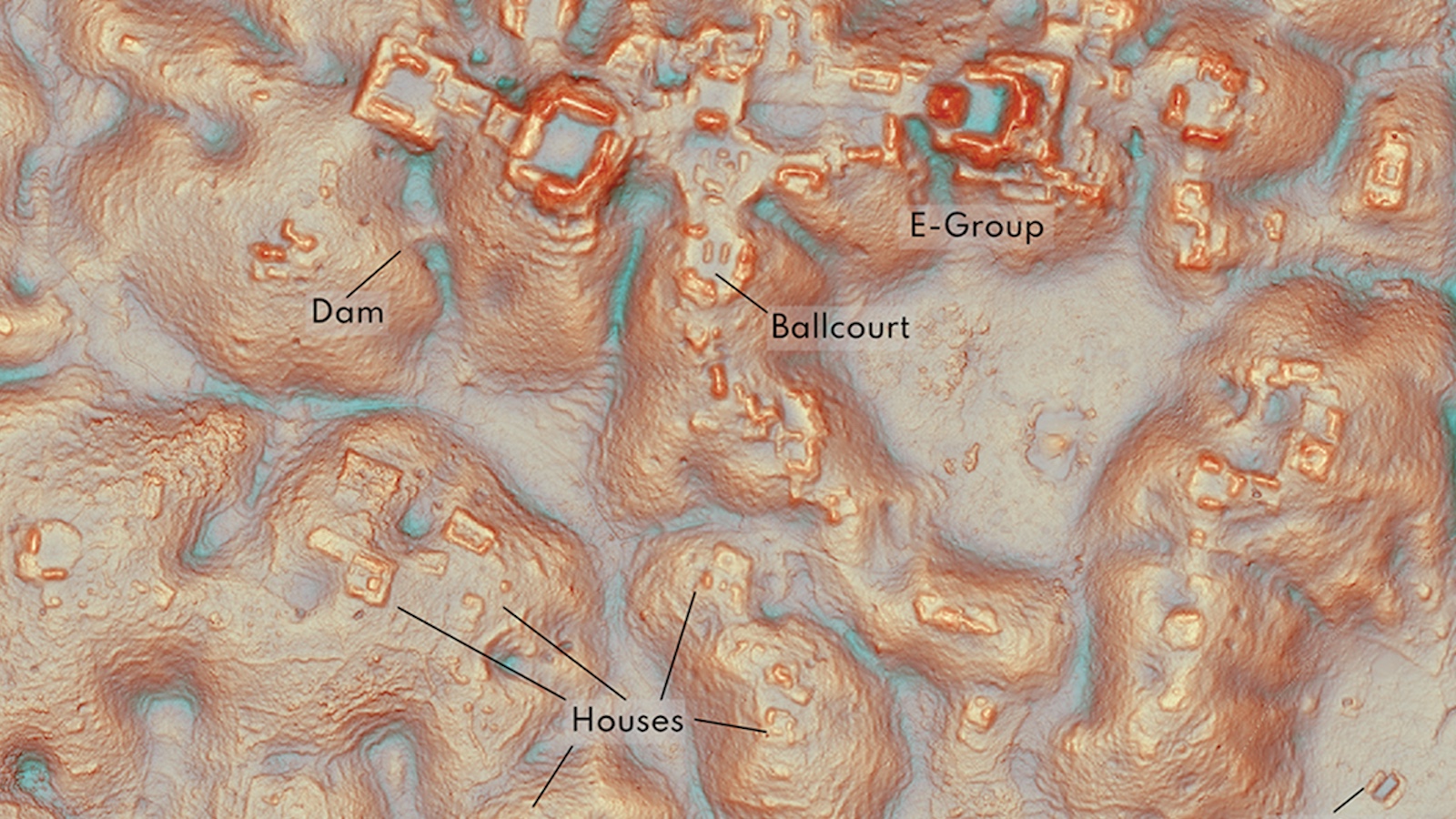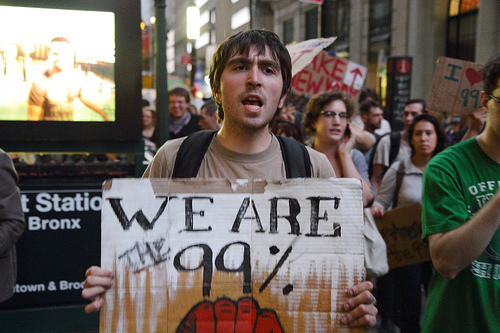Beyond Columbus the Hero, the Slave Driver, or the Bumbling Idiot

Happy Columbus Day! To be honest, it’s become a bit difficult to sort out exactly what we’re supposed to be celebrating. While earlier generations were raised with the myth of Columbus the Heroic Explorer, discoverer of America, recent years have brought us Columbus the Bumbling Idiot who bumped into America by accident, Columbus the Gold-Obsessed Slave Driver, and Columbus the Mass Murderer, responsible for the plague of smallpox that eventually wiped out 90% of the native American population.
We caught up with Mann in the middle of a busy book tour to ask him one question. With the permission of the publisher, we also include here an excerpt from the book.
single-celled protozoans Plasmodium vivax and Plasmodium falciparum.
P. vivax and P. falciparum are the two most important causes of human
malaria. Neither existed in the Americas before 1492. Vivax, which was
rampant in southeast England, was quickly ferried over in the bodies
of the first colonists to Virginia — certainly by the 1650s, possibly
before. Falciparum, the more deadly variety, came later, probably in
the 1680s. In the parts of the Americas warm enough for falciparum —
roughly speaking, the zone between Washington, DC, and Buenos Aires —
it became hard for Europeans to survive. Colonists who wanted to grow
tobacco, sugar or rice soon discovered that European indentured
servants died at high rates. Economically, planters were far better
off with African slaves, even though they were more expensive and less
willing to work, because most west and central Africans have inherited
immunities to malaria. In other words, malaria (and its companion,
yellow fever) greatly strengthened the economic case for slavery.
After Columbus, the distribution of the human species changed. Before
1492, almost all Europeans could be found in Europe, almost all
Africans lived in Africa, and almost all East Asians lived in East
Asia. After 1492, everything changed. Europeans became the dominant
population in places like Australia and Argentina, Africans occupied
much of Brazil, and Chinatowns popped up all over the globe.
The single most important part of this massive human shift was the
slave trade. Before 1820, the number of Africans
Europeans. Although we learn in school of the feats of Europeans
explorers, the greatest part of the meeting and mixing was a matter of
Africans, many of them escapees, encountering Native Americans. And an
enormous factor driving that movement was Plasmodium vivax and
Plasmodium falciparum, creatures of whose existence everyone involved
would be ignorant of for centuries to come.
Excerpt from Chapter 1: Two Monuments
The Seams of Panagaea
Although it had just finished raining, the air was hot and close. Nobody else was in sight; the only sound other than those from insects and gulls was the staticky low crashing of Caribbean waves. Around me on the sparsely covered red soil was a scatter of rectangles laid out by lines of stones: the outlines of now- vanished buildings, revealed by archaeologists. Cement pathways, steaming faintly from the rain, ran between them. One of the buildings had more imposing walls than the others. The researchers had covered it with a new roof, the only structure they had chosen to protect from the rain. Standing like a sentry by its entrance was a hand- lettered sign: Casa Almirante, Admiral’s House. It marked the first American residence of Christopher Columbus, Admiral of the Ocean Sea, the man whom generations of schoolchildren have learned to call the discoverer of the New World.
La Isabela, as this community was called, is situated on the north side of the great Caribbean island of Hispaniola, in what is now the Dominican Republic. It was the initial attempt by Europeans to make a permanent base in the Americas. (To be precise, La Isabela marked the beginning of consequential European settlement—Vikings had established a short-lived village in Newfoundland five centuries before.) The admiral laid out his new domain at the confluence of two small, fast- rushing rivers: a fortified center on the north bank, a satellite community of farms on the south bank. For his home, Columbus—Cristóbal Colón, to give him the name he answered to at the time—chose the best location in town: a rocky promontory in the northern settlement, right at the water’s edge. His house was situated perfectly to catch the afternoon light.
Today La Isabela is almost forgotten. Sometimes a similar fate appears to threaten its founder. Colón is by no means absent from history textbooks, of course, but in them he seems ever less admirable and important. He was a cruel, deluded man, today’s critics say, who stumbled upon the Caribbean by luck. An agent of imperialism, he was in every way a calamity for the Americas’ first inhabitants. Yet a different but equally contemporary perspective suggests that we should continue to take notice of the admiral. Of all the members of humankind who have ever walked the earth, he alone inaugurated a new era in the history of life.
The king and queen of Spain, Fernando (Ferdinand) II and Isabel I, backed Colón’s first voyage grudgingly. Transoceanic travel in those days was heart-toppingly expensive and risky—the equivalent, perhaps, of spaceshuttle flights today. Despite relentless pestering, Colón was able to talk the monarchs into supporting his scheme only by threatening to take the project to France. He was riding to the frontier, a friend wrote later, when the queen “sent a court bailiff posthaste” to fetch him back. The story is probably exaggerated. Still, it is clear that the sovereigns’ reservations drove the admiral to whittle down his expedition, if not his ambitions, to a minimum: three small ships (the biggest may have been less than sixty feet long), a combined crew of about ninety. Colón himself had to contribute a quarter of the budget, according to a collaborator, probably by borrowing it from Italian merchants.
Everything changed with his triumphant return in March of 1493, bearing golden ornaments, brilliantly colored parrots, and as many as ten captive Indians. The king and queen, now enthusiastic, dispatched Colón just six months later on a second, vastly larger expedition: seventeen ships, a combined crew of perhaps fifteen hundred, among them a dozen or more priests charged with bringing the faith to these new lands. Because the admiral believed he had found a route to Asia, he was sure that China and Japan— and all their opulent goods—were only a short journey beyond. The goal of this second expedition was to create a permanent bastion for Spain in the heart of Asia, a headquarters for further exploration and trade.
The new colony, predicted one of its founders, “will be widely renowned for its many inhabitants, its elaborate buildings, and its magnificent walls.” Instead La Isabela was a catastrophe, abandoned barely five years after its creation. Over time its structures vanished, their very stones stripped to build other, more successful towns. When a U.S.–Venezuelan archaeological team began excavating the site in the late 1980s, the inhabitants of La Isabela were so few that the scientists were able to move the entire settlement to a nearby hillside. Today it has a couple of roadside fish restaurants, a single, failing hotel, and a little-visited museum. On the edge of town, a church, built in 1994 but already showing signs of age, commemorates the first Catholic Mass celebrated in the Americas. Watching the waves from the admiral’s ruined home, I could easily imagine disappointed tourists thinking that the colony had left nothing meaningful behind— that there was no reason, aside from the pretty beach, for anyone to pay attention to La Isabela. But that would be a mistake.
Babies born on the day the admiral founded La Isabela—January 2, 1494— came into a world in which direct trade and communication between western Europe and East Asia were largely blocked by the Islamic nations between (and their partners in Venice and Genoa), sub- Saharan Africa had little contact with Europe and next to none with South and East Asia, and the Eastern and Western hemispheres were almost entirely ignorant of each other’s very existence. By the time those babies had grandchildren, slaves from Africa mined silver in the Americas for sale to China; Spanish merchants waited impatiently for the latest shipments of Asian silk and porcelain from Mexico; and Dutch sailors traded cowry shells from the Maldive Islands, in the Indian Ocean, for human beings in Angola, on the coast of the Atlantic. Tobacco from the Caribbean ensorcelled the wealthy and powerful in Madrid, Madras, Mecca, and Manila. Group smoke-ins by violent young men in Edo (Tokyo) would soon lead to the formation of two rival gangs, the Bramble Club and the Leather- breeches Club. The shogun jailed seventy of their members, then banned smoking.
Long-distance trade had occurred for more than a thousand years, much of it across the Indian Ocean. China had for centuries sent silk to the Mediterranean by the Silk Road, a route that was lengthy, dangerous, and, for those who survived, hugely profitable. But nothing like this worldwide exchange had existed before, still less sprung up so quickly, or functioned so continuously. No previous trade networks included both of the globe’s two hemispheres; nor had they operated on a scale large enough to disrupt societies on opposite sides of the planet. By founding La Isabela, Colón initiated permanent European occupation in the Americas. And in so doing he began the era of globalization—the single, turbulent exchange of goods and services that today engulfs the entire habitable world.
Newspapers usually describe globalization in purely economic terms, but it is also a biological phenomenon; indeed, from a long-term perspective it may be primarily a biological phenomenon. Two hundred and fifty million years ago the world contained a single landmass known to scientists as Pangaea. Geological forces broke up this vast expanse, splitting Eurasia and the Americas. Over time the two divided halves of Pangaea developed wildly different suites of plants and animals. Before Colón a few venturesome land creatures had crossed the oceans and established themselves on the other side. Most were insects and birds, as one would expect, but the list also includes, surprisingly, a few farm species—bottle gourds, coconuts, sweet potatoes—the subject today of scholarly head-scratching. Otherwise, the world was sliced into separate ecological domains. Colón’s signal accomplishment was, in the phrase of historian Alfred W. Crosby, to reknit the seams of Pangaea. After 1492 the world’s ecosystems collided and mixed as European vessels carried thousands of species to new homes across the oceans. The Columbian Exchange, as Crosby called it, is the reason there are tomatoes in Italy, oranges in the United States, chocolates in Switzerland, and chili peppers in Thailand. To ecologists, the Columbian Exchange is arguably the most important event since the death of the dinosaurs.
Unsurprisingly, this vast biological upheaval had repercussions on human kind. Crosby argued that the Columbian Exchange underlies much of the history we learn in the classroom—it was like an invisible wave, sweeping along kings and queens, peasants and priests, all unknowing. The claim was controversial; indeed, Crosby’s manuscript, rejected by every major academic publisher, ended up being published by such a tiny press that he once joked to me that his book had been distributed “by tossing it on the street, and hoping readers happened on it.” But over the decades since he coined the term, a growing number of researchers have come to believe that the ecological paroxysm set off by Colón’s voyages—as much as the economic convulsion he began—was one of the establishing events of the modern world.
On Christmas Day, 1492, Colón’s first voyage came to an abrupt end when his flagship, the Santa María, ran aground off the northern coast of Hispaniola. Because his two remaining vessels, the Niña and Pinta, were too small to hold the entire crew, he was forced to leave thirty- eight men behind. Colón departed for Spain while those men were building an encampment— a scatter of makeshift huts surrounded by a crude palisade, adjacent to a larger native village. The encampment was called La Navidad (Christmas), after the day of its involuntary creation (its precise location is not known today). Hispaniola’s native people have come to be known as the Taino. The conjoined Spanish-Taino settlement of La Navidad was the intended destination of Colón’s second voyage. He arrived there in triumph, the head of a flotilla, his crewmen swarming the shrouds in their eagerness to see the new land, on November 28, 1493, eleven months after he had left his men behind.
He found only ruin; both settlements, Spanish and Taino, had been razed. “We saw everything burned and the clothing of Christians lying on the weeds,” the ship’s doctor wrote. Nearby Taino showed the visitors the bodies of eleven Spaniards, “covered by the vegetation that had grown over them.” The Indians said that the sailors had angered their neighbors by raping some women and murdering some men. In the midst of the conflict a second Taino group had swooped down and overwhelmed both sides. After nine days of fruitless search for survivors Colón left to find a more promising spot for his base. Struggling against contrary winds, the fleet took almost a month to crawl a hundred miles east along the coast. On January 2, 1494, Colón arrived at the shallow bay where he would found La Isabela.
Almost immediately the colonists ran short of food and, worse, water. In a sign of his inadequacy as an administrator, the admiral had failed to inspect the water casks he had ordered; they, predictably, leaked. Ignoring all complaints of hunger and thirst, the admiral decreed that his men would clear and plant vegetable patches, erect a two- story fortress, and enclose the main, northern half of the new enclave within high stone walls. Inside the walls the Spaniards built perhaps two hundred houses, “small like the huts we use for bird hunting and roofed with weeds,” one man complained.*
Most of the new arrivals viewed these labors as a waste of time. Few actually wanted to set up shop in La Isabela, still less till its soil. Instead they regarded the colony as a temporary base camp for the quest for riches, especially gold. Colón himself was ambivalent. On the one hand, he was supposed to be governing a colony that was establishing a commercial entrepôt in the Americas. On the other hand, he was supposed to be at sea, continuing his search for China. The two roles conflicted, and Colón was never able to resolve the conflict.
On April 24 Colón sailed off to find China. Before leaving, he ordered his military commander, Pedro Margarit, to lead four hundred men into the rugged interior to seek Indian gold mines. After finding only trivial quantities of gold—and not much food—in the mountains, Margarit’s charges, tattered and starving, came back to La Isabela, only to discover that the colony, too, had little to eat—those left behind, resentful, had refused to tend gardens. The irate Margarit hijacked three ships and fled to Spain, promising to brand the entire enterprise as a waste of time and money. Left behind with no food, the remaining colonists took to raiding Taino storehouses. Infuriated, the Indians struck back, setting off a chaotic war. This was the situation that confronted Colón when he returned to La Isabela five months after his departure, dreadfully sick and having failed to reach China.
A loose alliance of four Taino groups faced off against the Spaniards and one Taino group that had thrown its lot in with the foreigners. The Taino, who had no metal, could not withstand assaults with steel weapons. But they made the fight costly for the Spaniards. In an early form of chemical warfare, the Indians threw gourds stuffed with ashes and ground hot peppers at their attackers, unleashing clouds of choking, blinding smoke. Protective bandannas over their faces, they charged through the tear gas, killing Spaniards. The intent was to push out the foreigners—an unthinkable course to Colón, who had staked everything on the voyage. When the Spaniards counterattacked, the Taino retreated scorched- earth style, destroying their own homes and gardens in the belief, Colón wrote scornfully, “that hunger would drive us from the land.” Neither side could win. The Taino alliance could not eject the Spaniards from Hispaniola. But the Spaniards were waging war on the people who provided their food supply; total victory would be a total disaster. They won skirmish after skirmish, killing countless natives. Meanwhile, starvation, sickness, and exhaustion filled the cemetery in La Isabela.
Humiliated by the calamity, the admiral set off for Spain on March 10, 1496, to beg the king and queen for more money and supplies. When he returned two years later— the third of what would become four voyages across the Atlantic—so little was left of La Isabela that he landed on the opposite side of the island, in Santo Domingo, a new settlement founded by his brother Bartolomé, whom he had left behind. Colón never again set foot in his first colony and it was almost forgotten.
Despite the brevity of its existence, La Isabela marked the beginning of an enormous change: the creation of the modern Caribbean landscape. Colón and his crew did not voyage alone. They were accompanied by a menagerie of insects, plants, mammals, and microorganisms. Beginning with La Isabela, European expeditions brought cattle, sheep, and horses, along with crops like sugarcane (originally from New Guinea), wheat (from the Middle East), bananas (from Africa), and coffee (also from Africa). Equally important, creatures the colonists knew nothing about hitchhiked along for the ride. Earthworms, mosquitoes, and cockroaches; honeybees, dandelions, and African grasses; rats of every description—all of them poured from the hulls of Colón’s vessels and those that followed, rushing like eager tourists into lands that had never seen their like before.





